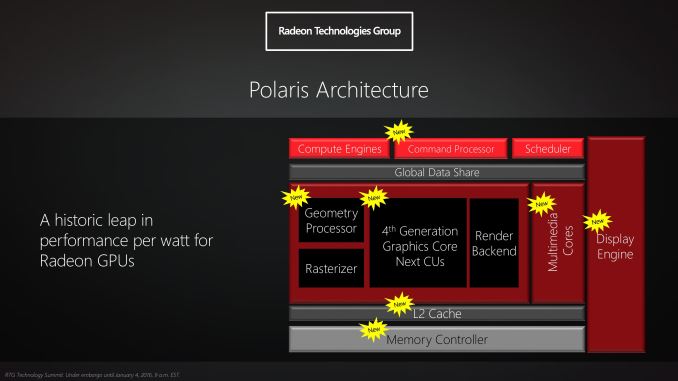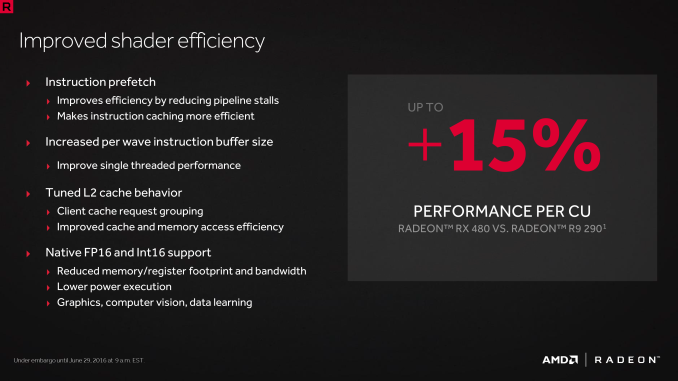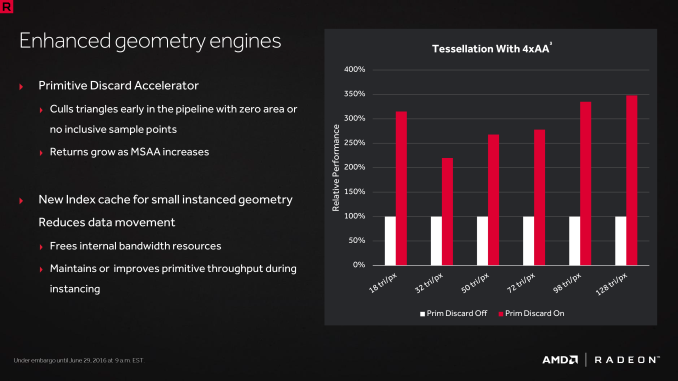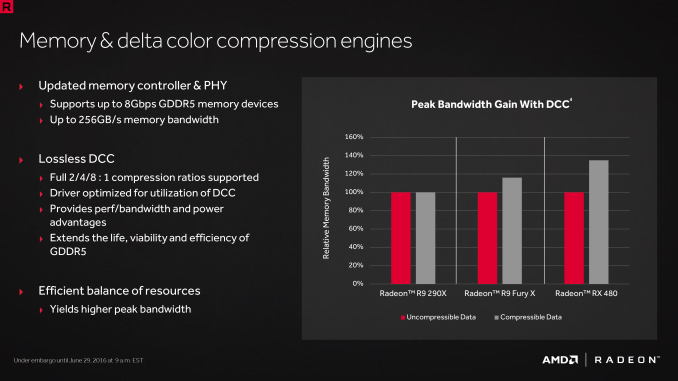The AMD Radeon RX 480 Preview: Polaris Makes Its Mainstream Mark
by Ryan Smith on June 29, 2016 9:00 AM ESTThe Polaris Architecture: In Brief
For today’s preview I’m going to quickly hit the highlights of the Polaris architecture.
In their announcement of the architecture this year, AMD laid out a basic overview of what components of the GPU would see major updates with Polaris. Polaris is not a complete overhaul of past AMD designs, but AMD has combined targeted performance upgrades with a chip-wide energy efficiency upgrade. As a result Polaris is a mix of old and new, and a lot more efficient in the process.
At its heart, Polaris is based on AMD’s 4th generation Graphics Core Next architecture (GCN 4). GCN 4 is not significantly different than GCN 1.2 (Tonga/Fiji), and in fact GCN 4’s ISA is identical to that of GCN 1.2’s. So everything we see here today comes not from broad, architectural changes, but from low-level microarchitectural changes that improve how instructions execute under the hood.
Overall AMD is claiming that GCN 4 (via RX 480) offers a 15% improvement in shader efficiency over GCN 1.1 (R9 290). This comes from two changes; instruction prefetching and a larger instruction buffer. In the case of the former, GCN 4 can, with the driver’s assistance, attempt to pre-fetch future instructions, something GCN 1.x could not do. When done correctly, this reduces/eliminates the need for a wave to stall to wait on an instruction fetch, keeping the CU fed and active more often. Meanwhile the per-wave instruction buffer (which is separate from the register file) has been increased from 12 DWORDs to 16 DWORDs, allowing more instructions to be buffered and, according to AMD, improving single-threaded performance.
Outside of the shader cores themselves, AMD has also made enhancements to the graphics front-end for Polaris. AMD’s latest architecture integrates what AMD calls a Primative Discard Accelerator. True to its name, the job of the discard accelerator is to remove (cull) triangles that are too small to be used, and to do so early enough in the rendering pipeline that the rest of the GPU is spared from having to deal with these unnecessary triangles. Degenerate triangles are culled before they even hit the vertex shader, while small triangles culled a bit later, after the vertex shader but before they hit the rasterizer. There’s no visual quality impact to this (only triangles that can’t be seen/rendered are culled), and as claimed by AMD, the benefits of the discard accelerator increase with MSAA levels, as MSAA otherwise exacerbates the small triangle problem.
Along these lines, Polaris also implements a new index cache, again meant to improve geometry performance. The index cache is designed specifically to accelerate geometry instancing performance, allowing small instanced geometry to stay close by in the cache, avoiding the power and bandwidth costs of shuffling this data around to other caches and VRAM.
Finally, at the back-end of the GPU, the ROP/L2/Memory controller partitions have also received their own updates. Chief among these is that Polaris implements the next generation of AMD’s delta color compression technology, which uses pattern matching to reduce the size and resulting memory bandwidth needs of frame buffers and render targets. As a result of this compression, color compression results in a de facto increase in available memory bandwidth and decrease in power consumption, at least so long as buffer is compressible. With Polaris, AMD supports a larger pattern library to better compress more buffers more often, improving on GCN 1.2 color compression by around 17%.
Otherwise we’ve already covered the increased L2 cache size, which is now at 2MB. Paired with this is AMD’s latest generation memory controller, which can now officially go to 8Gbps, and even a bit more than that when oveclocking.














449 Comments
View All Comments
Ryan Smith - Wednesday, June 29, 2016 - link
Thanks!pavag - Wednesday, June 29, 2016 - link
Ok. I don't want this card. I want more performance.The interesting thing this generation will be the gap between this and the GTX 1070.
Bruce Woolloomooloo - Wednesday, June 29, 2016 - link
It amazes me how many people defend companies as if they're their friend. People need to understand for $199 it's the best performing card on the market.AntDX316 - Thursday, June 30, 2016 - link
and #1 in performance per dollar but performance per watt is what has to remain hiddenakamateau - Wednesday, June 29, 2016 - link
2 RX 480 8gb for $479.98 Crossfire OUTPERFORMS GTX 1080 for $659.99!!!Get em on Amazon AND Newegg.
rav55 - Wednesday, June 29, 2016 - link
RX 480 shines in Crossfire mode.2 RX 480 8gb for $479.98 OUTPERFORMS GTX 1080 for $659.99.
BUY AMERICAN!!
vladx - Wednesday, June 29, 2016 - link
Wow so many AMD shillsD. Lister - Thursday, June 30, 2016 - link
You should make one more fake ID just to make sure that someone believes your nonsense.Secondly, Nvidia is an American company from day one, while AMD's GPU division used to be a Canadian company called ATI.
Thirdly, anyone who bases their purchase decision solely based on the nationality of a company, is an idiot, period. Especially in this day and age where everyone and their uncle is outsourcing to China and India.
AntDX316 - Thursday, June 30, 2016 - link
for tools, food, and gas 100% agree buy AmericanIf you take all your electronics, found out you have to pay like 4x of what they are worth that you didn't to someone like the IRS because you decided to get the same exactly quality but American, would you still agree to buy American? I'm just saying all the money you saved by going outsource has to be paid for because we have to pretend it had to be made from here with all the added cost of salaries that everyone had to do from here. Would you file for bankruptcy or take a huge loan out?
catavalon21 - Wednesday, July 13, 2016 - link
The review HardOCP did on the 480 in CF mode against the 1080 and 1070 suggests statement missed the mark. Great review they did. If you're serious about the subject, give it a look.